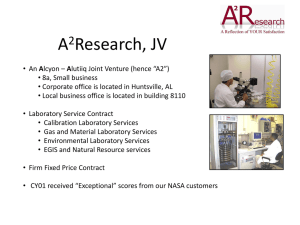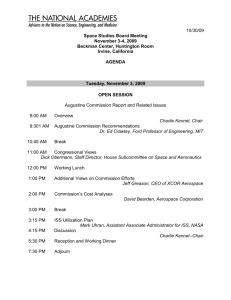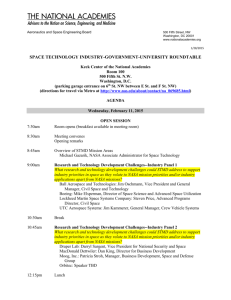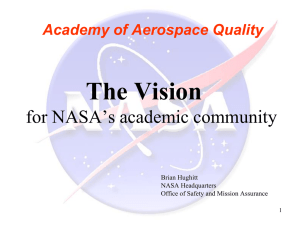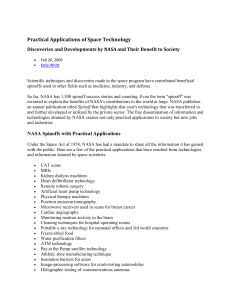- Mains Associates
advertisement
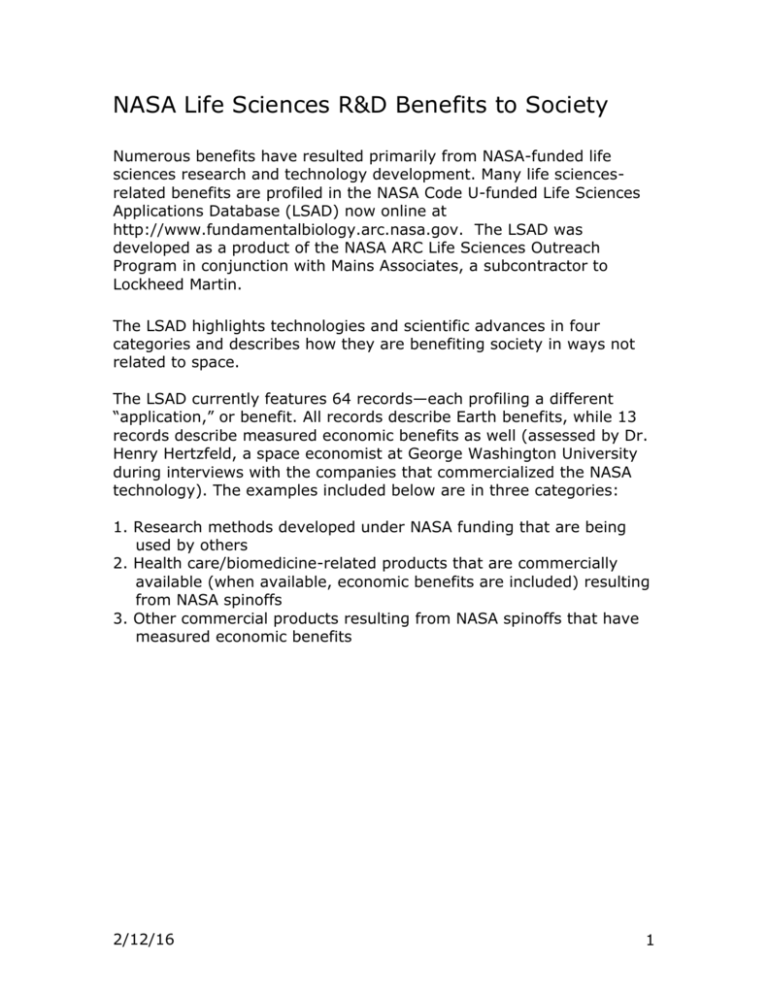
NASA Life Sciences R&D Benefits to Society Numerous benefits have resulted primarily from NASA-funded life sciences research and technology development. Many life sciencesrelated benefits are profiled in the NASA Code U-funded Life Sciences Applications Database (LSAD) now online at http://www.fundamentalbiology.arc.nasa.gov. The LSAD was developed as a product of the NASA ARC Life Sciences Outreach Program in conjunction with Mains Associates, a subcontractor to Lockheed Martin. The LSAD highlights technologies and scientific advances in four categories and describes how they are benefiting society in ways not related to space. The LSAD currently features 64 records—each profiling a different “application,” or benefit. All records describe Earth benefits, while 13 records describe measured economic benefits as well (assessed by Dr. Henry Hertzfeld, a space economist at George Washington University during interviews with the companies that commercialized the NASA technology). The examples included below are in three categories: 1. Research methods developed under NASA funding that are being used by others 2. Health care/biomedicine-related products that are commercially available (when available, economic benefits are included) resulting from NASA spinoffs 3. Other commercial products resulting from NASA spinoffs that have measured economic benefits 2/12/16 1 Research Methods New Technique for Nerve Reattachment NASA Center: Ames Research Center Description: This technique involves a new staining process that distinguishes between sensory and motor axons. With this tool, the regenerative capability of injured nerves can be determined. NASA’s Need: The discovery was made in the process of analyzing tissue from space-flown rats. Earth Benefits: The new staining process provides a diagnostic tool for surgeons to determine the regeneration capability of injured nerves. Benefits of the process include improved techniques to reattach limbs, a diagnostic tool for organ transplants, and the correction of old injuries repaired before the technique existed. Rodent Model to Simulate Spaceflight Effects NASA Center: Ames Research Center Description: The rodent model for hindlimb unloading, developed in the 1970s at NASA ARC, has been used in many laboratories around the world to study musculoskeletal unloading. Hindlimbs of rodents are elevated to produce a head-down tilt, avoiding weightbearing by the hindquarters. NASA’s Need: NASA life scientists at Ames Research Center sought a rodent ground-based model to simulate microgravity and thereby help predict changes that would be seen as a result of space flight. Earth Benefits: This model not only mimics spaceflight but also has proven to be useful for investigating physiological responses for both rats and mice to the recovery process associated with reloading as well as unloading, providing insights into spaceflight-based and Earth-based health problems. Studies within such fields as exercise physiology and sports medicine have also used this technique. 2/12/16 2 Health Care/Biomedicine-related Products Baroreflex Cuff NASA Center: Johnson Space Center Description: The Baroreflex Cuff is a blood pressure measurement system that works by stimulating the carotid baroreceptors by applying either negative or positive pressure to the neck. NASA’s Need: Weightlessness alters the body’s blood pressure controls. NASA is trying to understand the reasons for this so that negative effects can be lessened. Earth Benefits: The Baroreflex Cuff is now used in clinics to evaluate patients’ blood pressure control. Economic Benefits: Company EDL, Inc. Company Benefits NASA investment in the company has resulted in approximately a doubling by the company of the initial R&D, with significant sales back to the government. The company itself was created due to its founders’ association with NASA. Cumulative Sales* $1-10 million Societal Benefits The Cuff is currently a research instrument, but EDL, Inc. is researching the use of new materials to bring the price down for commercial clinical use. Bioreactor NASA Center: Johnson Space Center Description: The Bioreactor is a cell life support device that cultures cells in a horizontal cylinder that slowly rotates, producing lower environmental stress. This allows for the formation of 3D cultures more similar to normal tissue growth. NASA’s Need: The Bioreactor was designed as a ground support system to keep cell culture experiments fresh while in transit to the Shuttle. Earth Benefits: The Bioreactor is an excellent tool for conducting pioneering research in lung tissue, skin growth, intestinal disease, cartilage growth, colon cancer, brain 2/12/16 3 tumor growth, and therapeutics. Prior to the development of the Bioreactor, robust three-dimensional tissue growth on Earth could not be accomplished. Economic Benefits: Company Synthecon, Inc. Company Benefits The company has spent more than twice NASA’s investment in R&D, and it continues to have significant sales back to the government (about 90% of total sales). Synthecon is an example of a company that was formed due to NASA contracts. Cumulative Sales* $1-10 million Societal Benefits Currently, the company is trying to scale up their products for large scale commercial work. Cardio-muscular Conditioner NASA Center: Headquarters Description: The Shuttle 2000-1, a cardio-muscular conditioner, provides a safe, injuryfree environment for plyometric exercise (power conditioning) and the training of specific muscle groups. NASA’s Need: NASA researched methods of cardiovascular conditioning in microgravity for Skylab. Earth Benefits: The cardio-muscular conditioner exercise system is used by teams in the National Football League, strength coaches, and medical rehabilitation centers. Economic Benefits: Not yet determined Cool Suit NASA Center: Ames Research Center Description: The Cool Suit is a portable, fully insulated cooling garment, which lowers body temperature by circulating chilled water between its layers. 2/12/16 4 NASA’s Need: The Cool Suit is a spin-off of NASA's Mark VII suit of the 1960s: a channeled cooling garment for astronauts to wear underneath a spacesuit during extravehicular activities. Earth Benefits: Technology related to NASA’s Cool Suit has been adapted to create various similar garments that have helped to cool people with impaired temperature control conditions, workers in extremely hot areas, crop-duster pilots, and other applications. As of May 1994, NASA is also working with the Multiple Sclerosis Association of America on research into the use of LCG’s for Multiple Sclerosis patients. Economic Benefits: Company ILC Dover, Inc. Company Benefits NASA has had a continuous R&D relationship with ILC Dover, since the development of the Apollo space suit. Company R&D has been equal or greater than NASA’s contribution. ILC Dover, Inc. is an example of a company that is dependent on its NASA history. Cumulative Sales* > $100 million Societal Benefits The Cool Suit is now much less expensive to manufacture. Spinoffs from the original model have applications ranging from industry safety to medical symptom relief. Fetal Biotelemetry System NASA Center: Ames Research Center Description: Surgeons at the University of California, San Francisco Fetal Treatment Center (FTC) have developed an in-utero surgical procedure to correct lifethreatening physical anomalies in human fetuses. Such surgical intervention requires wireless telemetry to effectively monitor mother and fetus during and after surgery. The Fetal Biotelemetry System (FBS) consists of a biotelemetry monitoring device, a commercially available implantable sensor, and an implantable fetal pH sensor that is under development. NASA’s Need: The sensors used in the Fetal Biotelemetry System were developed under the Sensors 2000! Program to monitor the health of astronauts in space. 2/12/16 5 Earth Benefits: With the FBS, surgeons can wirelessly monitor pH, heart rate, and body temperature in the human fetus in order to detect and treat potentially fatal physical anomalies. Economic Benefits: Not yet determined. Food Warming System NASA Center: Johnson Space Center Description: The 3M Food Service System used in hospitals and nursing homes, derived from the system they developed for NASA, uses a cook/chill process to save preparation time and cost. NASA’s Need: NASA contracted with 3M Health Care in the 1960s to produce a meal service system for the Apollo lunar spacecraft. Earth Benefits: The Food Warming System increases scheduling flexibility and lowers labor and total operating costs for health care operations. Economic Benefits: Company 3M Health Care Company Benefits 3M first developed the technology used in today’s product under a contract to NASA to provide a food warming system for the Apollo lunar missions. A small amount of NASA R&D was leveraged into a large company investment. Cumulative Sales* > $100 million Societal Benefits The product improves food service efficiency and nutrient retention in hospitals and nursing homes. Infrared Thermometer NASA Center: Jet Propulsion Laboratory Description: The infrared thermometer consists of a plastic-covered probe, which is inserted into the ear canal of the patient, and uses an IR sensor to measure the heat from the tympanic membrane. 2/12/16 6 NASA’s Need: NASA developed the technology used in the infrared thermometer for remote sensing of star and planet temperatures. Earth Benefits: In the U.S. alone, about two billion clinical temperature readings are taken annually. The national shortage of nursing personnel spurred Diatek Corporation to develop a faster thermometer. Based on NASA-funded infrared technology the Model 7000 Thermometer offers quick operation and extreme accuracy. Earth Benefits: Company Diatek, Inc. (a Welch Allyn Co.) Company Benefits Collaboration with JPL allowed Diatek access to three decades of experience in infrared radiation technology. Company R&D was returned over 40 times in cumulative sales. Cumulative Sales* $10–100 million Societal Benefits The IR Thermometer provides a significantly faster and less invasive method of taking temperatures. The production of the product creates jobs, and the faster operation aids the current nursing shortage in the U.S. Mechanical Response Tissue Analyzer (MRTA) NASA Center: Ames Research Center Description: The Mechanical Response Tissue Analyzer (MRTA) is a portable device that measures bending stiffness of bones by their response to a brief vibratory stimulus. NASA’s Need: NASA needed a non-invasive, inexpensive way of making direct measurements of bone stiffness and mass in order to study and potentially counteract microgravity-induced bone mass loss. Earth Benefits: The MRTA provides an excellent non-radiation measure of long bone strength that is substantially less expensive than current methods. The MRTA is the only instrument that provides a direct and non-invasive measure of bending stiffness in the ulna and tibia, parts of the body directly involved in weight-bearing activities. Economic Benefits: Not yet determined. 2/12/16 7 Microbe Detector NASA Center: Headquarters Description: The Automated Microbe System (AMS) uses disposable cards and chemical testing to detect microbes in the human body, saving time and money over traditional petri dish-based culturing methods. NASA’s Need: The NASA microbe-sensing technology was originally developed by McDonnell-Douglas for use on the Viking Landers. Earth Benefits: The AMS incorporates space technology to significantly reduce analysis time for detection of infection in body fluids and includes a computer examination to determine which antibiotic is most effective against the infecting organism. All of this combines to drastically reduce treatment time. Economic Benefits: Company bioMerieux-Vitek, Inc. Company Benefits The system is more automated than others available and currently possesses about half the market in sales. The link with NASA R&D has been crucial for company publicity, convincing customers to try the automated system. Cumulative Sales* > $100 million Societal Benefits The shorter analysis time required reduces labor costs and patient time in the hospital. The product is helpful for lessdeveloped countries, where highly skilled staff are not readily available. Rapid Heat Transfer Sterilizer NASA Center: Langley Research Center Description: The Cox Rapid Heat-Transfer Sterilizer (RHTS) uses dry heat and high velocity airflow to drastically reduce sterilization time for dental and medical instruments. NASA’s Need: NASA conducted research into dry heat sterilization techniques for the Viking Lander mission and published a series of articles on its findings. Earth Benefits: The reduction in instrument damage made possible by the RHTS, coupled with the reduced sterilization time, could make a drastic reduction in 2/12/16 8 instrument inventory possible, leading to thousands of dollars in savings. Economic Benefits: Company CoxSterile, Inc. Company Benefits The NASA publication prompted the developer to spend over $1 million on his own R&D. The new sterilization technique was the first to pass FDA approval. Cumulative Sales* $10-100 million Societal Benefits The sterilization device increases productivity and savings in dentists’ offices by reducing the number of instruments needed and number damaged due to longer sterilization processes. Temperature Pill NASA Center: Goddard Space Flight Center Description: The Ingestible Thermal Monitoring System (ITMS) is a small capsule containing a telemetry system and temperature sensor, providing continuous monitoring of internal temperature. NASA’s Need: NASA has done extensive research in wireless telemetry to monitor astronauts in orbit. Similar technology was incorporated into the temperature pill. Earth Benefits: The ITMS has uses both in health care and many production processes, such as food processing, where the pill can be embedded in manufacturing equipment for constant temperature monitoring to ensure food safety. Economic Benefits: Company Human Technologies Inc. Company Benefits The development of the commercial temperature pill showed significant leveraging of NASA R&D into company spending. The tie to NASA has increased credibility, sales, and joint ventures. 2/12/16 Cumulative Sales* $1-10 million Societal Benefits In addition to use in sports medicine, gerontology, substance abuse monitoring, and the study of metabolic disease, the temperature pill is finding new applications in industry, where sales may outnumber medical sales in the long run. 9 Other Products with Measured Economic Benefits Gas Analyzer NASA Center: Ames Research Center Description: The gas analyzer uses a micromachined silicon wafer gas chromatograph. This is a commercialized version of the miniature chromatograph built for the Viking Lander Program. NASA’s Need: The technology used in the gas analyzer was developed for NASA at Stanford University in the 1970s. It was part of the Viking Lander analysis system used to search for life on Mars. Earth Benefits: Able to detect potentially harmful gases in minute concentrations, the Gas Analyzer is an extremely effective portable device to detect gas leaks in industrial environments. The entire unit weighs only 12 pounds and completes most analyses in less than 30 seconds. It can analyze concentrations as low as one part per million. Economic Benefits: Company MTI Analytical Instruments Company Benefits The company was founded by four researchers who worked on the original Stanford research for NASA. MTI has spent approximately four times the original government R&D to improve the product. Cumulative Sales* $10–100 million Societal Benefits The gas analyzer has been used in such diverse applications as trash disposal and insulin manufacturing. Use of the analyzer in drug manufacturing, for monitoring the reuse of by-products, can save the company up to a million dollars. Orbital Workout Machine NASA Center: Johnson Space Center Description: The Orbotron is an exercise machine consisting of three rings corresponding to pitch, roll, and yaw. The user is situated in the middle ring, supported by hand grips and foot restraints. NASA’s Need: The Orbital Workout Machine was based on a NASA device that is designed to 2/12/16 10 simulate the disorientation experienced in space. Earth Benefits: A study by the Department of Exercise Science at the University of Southern California concluded that the Orbotron improves aerobic capacity, strength, and endurance. The rings start spinning with a push, and the user can then move in any direction without experiencing motion sickness. A person using the Orbotron does not experience motion sickness, due to the even distribution of force in all three planes of motion. Earth Benefits: Company Orbotron, Inc. Company Benefits Using their own R&D and a NASA idea, the founders of the company have sold about 800 Orbotrons world-wide, at a cost of $11,000– 17,000 per unit. The NASA connection is still being used in the company’s marketing strategy. Cumulative Sales* $10–100 million Societal Benefits The amusement park usage of the machine generates jobs and profits for owners many times the price of the unit. Resistive Exercise Device NASA Center: Ames Research Center Description: The ExerGenie tested during the Apollo missions was developed from a novel fire-escape system that proved to have applications as a resistive exercise device. NASA’s Need: NASA originally tested resistive exercise devices to assist the Apollo crews in maintaining musculoskeletal and cardiovascular health. Earth Benefits: The product is now being sold commercially, at the rate of 50–100 systems a month. Economic Benefits: Company Team America Health and Fitness, Inc. Company Benefits The NASA connection is still being used to market the device, since NASA funding was spent testing it during the Apollo program. The 2/12/16 Cumulative Sales* $10–100 million Societal Benefits The device’s light weight and small size make it an effective portable exercise system. 11 company sells about 50–100 units a month. Tempur Foam NASA Center: Ames Research Center, Johnson Space Center Description: Tempur Foam is a material that retains its form in its natural state. When under pressure by a warm object, it contours to the natural curves of the contacted surface without any pressure points. NASA’s Need: Tempur Foam was first developed by NASA in the 1960s to improve seat cushioning and crash protection for airplane pilots and passengers, and later tested for use in astronaut launch couches. Earth Benefits: Because it conforms to contacting surfaces, Tempur Foam is ideal for a number of commercial applications on Earth. It can also be used in medical environments or any situation where a person is bed-ridden for a long period of time to prevent the formation of bed sores. Economic Benefits: Company Tempur-Pedic, Inc. Company Benefits Fagerdala, the company that manufactures the product for Tempur-Pedic, did its own R&D to improve on the original NASA design, making it a longer-lasting product. The company still makes extensive use of the product’s NASA origin in advertising. Cumulative Sales* $10–100 million Societal Benefits There are large downstream benefits in preventative medicine. In the field of bedsore prevention, there is an estimated 4 to 1 return on government investment. *Product sales plus company R&D investment numbers are cumulative through 1997, have been converted to $1997, and are presented as falling within a range for reasons of confidentiality, as requested by the interviewees. 2/12/16 12


